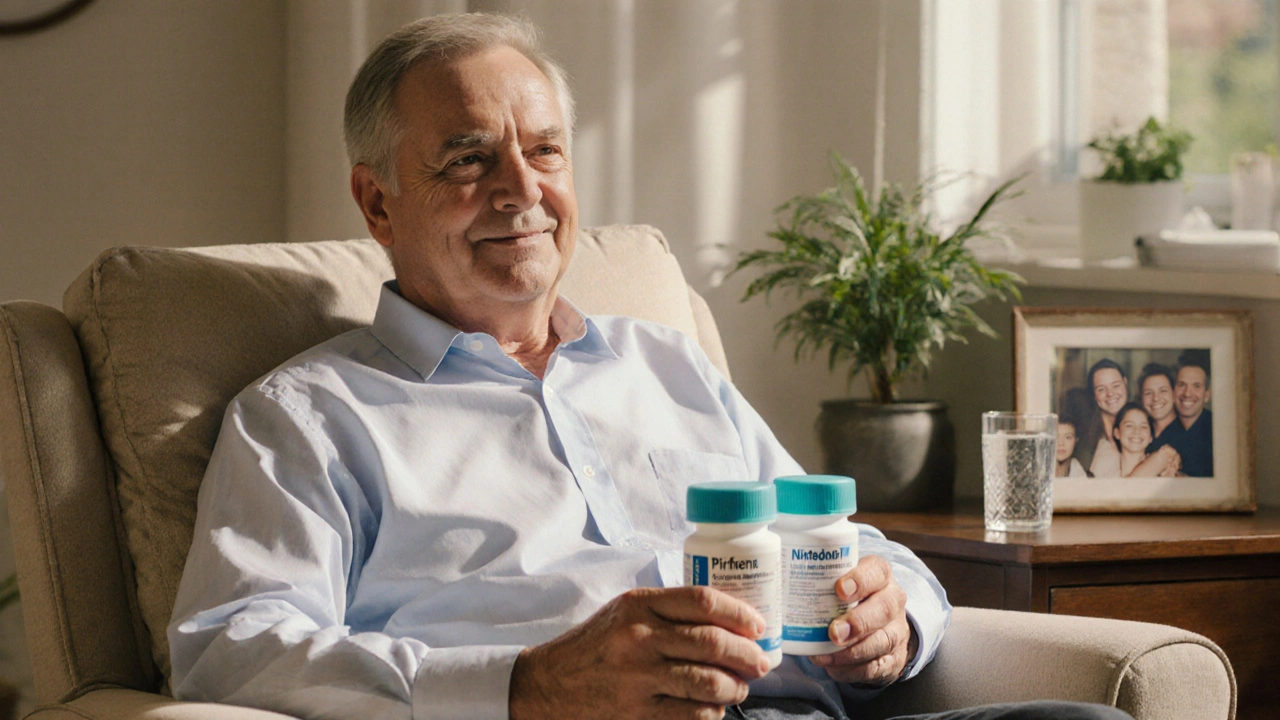IPF Medication Decision Tool
Use this tool to help determine whether Pirfenex or nintedanib may be more suitable for your IPF treatment based on key factors.
Personal Health Factors
Key Takeaways
- Pirfenex (pirfenidone) and nintedanib are the only two FDA‑approved drugs that slow idiopathic pulmonary fibrosis (IPF).
- Pirfenex works by reducing fibroblast activity, while nintedanib blocks multiple growth‑factor receptors.
- Both drugs show similar reductions in forced vital capacity (FVC) decline (≈50% vs placebo), but side‑effect profiles differ.
- Cost is a major decision point: Pirfenex’s generic version can be 30‑40% cheaper than brand‑name, whereas nintedanib remains priced at premium levels.
- Patient‑specific factors-age, liver function, GI tolerance, and insurance coverage-should drive the final choice.
When facing an IPF diagnosis, the first question most patients ask is: “Which drug will keep my lungs from getting worse?” The two main contenders are Pirfenex (pirfenidone) and its biggest rival, nintedanib. Below we break down every angle you need to weigh-efficacy, safety, dosing, cost, and real‑world experience-so you can decide which therapy aligns with your health goals and lifestyle.
What is Pirfenex (pirfenidone)?
Pirfenex is a synthetic collagen‑synthesis inhibitor marketed for idiopathic pulmonary fibrosis. It was first approved by the U.S. Food and Drug Administration (FDA) in 2014 and is available worldwide under several brand names. The active ingredient, pirfenidone, interferes with transforming growth factor‑beta (TGF‑β) signaling, which slows the formation of scar tissue in the lungs.
How does nintedanib work?
Nintedanib is a tyrosine‑kinase inhibitor that blocks signaling pathways of fibroblast growth factor, platelet‑derived growth factor, and vascular endothelial growth factor. By shutting down these pathways, nintedanib reduces the proliferation of fibroblasts and the deposition of extracellular matrix, which also curtails fibrosis progression.
Key differences in mechanism of action
While both drugs aim to halt scarring, Pirfenex targets a single cytokine cascade (TGF‑β), whereas nintedanib casts a wider net across several growth‑factor receptors. This broader blockade explains why nintedanib often produces more gastrointestinal (GI) upset, but also why some clinicians consider it a stronger option for patients with rapid disease progression.
Clinical efficacy side by side
Two pivotal PhaseIII trials-CAPACITY for pirfenidone and INPULSIS for nintedanib-provide the evidence base. Both studies showed roughly a 50% reduction in the annual decline of forced vital capacity (FVC) compared with placebo. A head‑to‑head meta‑analysis published in 2023 found no statistically significant difference in overall survival, but highlighted subtle trends:
- Patients with baseline FVC>80% tended to preserve lung function slightly better on pirfenidone.
- Those with a history of rapid FVC loss (>10% in the prior year) sometimes responded more robustly to nintedanib.

Safety and tolerability
Understanding side‑effects is crucial because they dictate adherence. Below is a quick snapshot:
- Pirfenex: Common-photosensitivity, rash, mild nausea, and loss of appetite. Liver enzyme elevations occur in ~15% of patients; monthly liver function tests are mandatory.
- Nintedanib: Common-diarrhea (up to 60% of users), nausea, abdominal pain, and decreased appetite. Elevated liver enzymes are less frequent but still require regular monitoring.
Both drugs carry a boxed warning for severe liver toxicity, so baseline and follow‑up liver panels are non‑negotiable.
Dosage and administration
| Attribute | Pirfenex (pirfenidone) | Nintedanib |
|---|---|---|
| Formulation | Capsules 267mg | Capsules 100mg |
| Typical daily dose | 801mg (3×267mg) after titration | 300mg (3×100mg) twice daily |
| Titration period | 2‑week upward titration | No titration required |
| Administration | Oral with food (to reduce GI upset) | Oral, may be taken with or without food |
| Monitoring | Liver enzymes, photosensitivity precautions | Liver enzymes, manage diarrhea proactively |
Cost considerations
Affordability often decides which drug patients actually stay on. In the United States, brand‑name Pirfenex averages US$5,500 per month, while the approved generic pirfenidone drops the price to roughly US$3,300. Nintedanib (Ofev) sits around US$6,800 per month with limited generic competition.
Insurance coverage varies. Medicare PartD typically places both drugs in high‑tier formularies, meaning co‑pays can reach several hundred dollars. Patient assistance programs exist for both manufacturers, but eligibility criteria differ. If out‑of‑pocket cost is a barrier, the generic pirfenidone option often opens the door to sustained therapy.
Choosing the right drug for you
There isn’t a one‑size‑fits‑all answer. Here’s a quick decision‑tree you can run through with your pulmonologist:
- Do you have a history of liver disease?-If yes, the drug with the milder hepatic profile (often nintedanib) may be preferable.
- Are you prone to diarrhea or have a sensitive gut?-Pirfenex tends to cause less GI distress.
- Is photosensitivity a concern (e.g., you work outdoors)?-You’ll need strict sun protection on Pirfenex, otherwise nintedanib might be easier.
- Is cost the biggest hurdle?-Check generic pirfenidone availability; it usually wins on price.
- Do you need a rapid‑onset effect?-Some clinicians observe a slightly quicker stabilization of FVC on nintedanib for aggressive disease.
Ultimately, shared decision‑making-balancing clinical data, personal tolerance, and financial reality-delivers the best long‑term outcomes.
Practical tips for staying on therapy
- Set up a medication calendar. Both drugs require daily dosing; missing doses can blunt efficacy.
- Schedule liver function tests at baseline, then every 3months for the first year.
- For Pirfenex, apply sunscreen SPF30+ daily and wear protective clothing.
- For nintedanib, keep anti‑diarrheal agents (e.g., loperamide) on hand and stay hydrated.
- Discuss any new symptoms with your care team immediately; early management prevents discontinuation.
Frequently Asked Questions
Can I switch from Pirfenex to nintedanib or vice‑versa?
Yes, but you need a wash‑out period (usually 1-2weeks) to avoid overlapping side‑effects. Your pulmonologist will monitor liver enzymes before and after the switch.
Is there any benefit to using both drugs together?
Current guidelines advise against combination therapy because of increased toxicity without proven additive efficacy. Clinical trials are ongoing, but monotherapy remains the standard of care.
How long do I need to stay on Pirfenex?
IPF is a chronic disease, so treatment is typically lifelong unless side‑effects become unmanageable or a lung transplant is performed.
Are there any dietary restrictions?
Take Pirfenex with food to reduce nausea. For nintedanib, a high‑fat meal can increase absorption, but it also raises the chance of diarrhea, so a balanced meal is recommended.
What if my insurance won’t cover the medication?
Both manufacturers offer patient‑assistance programs. You can also appeal to your insurer using a physician‑written justification that cites the FDA’s indication for IPF.






Reviews
The comparison feels like a marketing fluff piece that glosses over the real-world adherence issues with pirfenidone.
While the side‑effect profile is important, many patients find that gradual titration and diligent sunscreen use can make pirfenidone tolerable, so it’s worth discussing these strategies with your pulmonologist.
Wow, this breakdown really shines a light on the trade‑offs, and it’s amazing how much the “cost vs. convenience” factor can tip the scales for patients 🤯💊.
I must point out, first and foremost, that the article contains several inaccuracies that merit correction. The claim that pirfenidone “typically causes less GI upset” is an oversimplification; studies have shown nausea in up to 30 % of patients, which is non‑trivial. Moreover, the phrase “strict sun protection” is vague – it should specify SPF 30+ broad‑spectrum sunscreen applied every two hours. The discussion of liver enzyme monitoring is also incomplete; guidelines recommend baseline testing followed by monthly checks for the first six months, not merely “regular monitoring.” Additionally, the cost comparison neglects the existence of patient‑assistance programs that can reduce out‑of‑pocket expenses dramatically. It is also erroneous to state that nintedanib “has a milder hepatic profile” without citing the comparative incidence of ALT/AST elevations, which are actually similar between the two drugs. The table regarding dosage omits the need for a 2‑week titration period for pirfenidone, which is critical to reduce early adverse events. Furthermore, the statement about “rapid‑onset effect” lacks supporting evidence; neither drug has been shown to produce immediate stabilization of FVC. The article’s tone occasionally drifts into promotional language, for example when describing “premium levels” of nintedanib pricing, which could be rephrased for neutrality. I also noticed inconsistent use of the brand name versus generic terminology, which may confuse readers. The recommendation algorithm oversimplifies patient heterogeneity; factors such as comorbid heart disease are not considered. Finally, the citation of a 2023 meta‑analysis should include a proper reference link for verification. In sum, while the piece is a useful starting point, it requires substantial editorial polishing to meet scholarly standards.
The mechanistic divergence-pirfenidone’s selective TGF‑β inhibition versus nintedanib’s broad tyrosine‑kinase blockade-suggests that patient‑specific molecular phenotyping could eventually guide therapy, a nuance that current guidelines have yet to embrace.
Although your exposition is intellectually stimulating, the occasional misuse of “than” instead of “then” and the missing commas after introductory clauses slightly impede readability.
Hey, no worries! I get that the scientific jargon can feel dense, but the core idea is that both drugs aim to slow scarring, just by different routes, and that’s the takeaway for most folks.
Honestly, the article reads like a sales brochure; it glosses over the fact that many patients discontinue therapy within the first year due to intolerable side effects.
It’s true that dropout rates are concerning, yet the data also show that with proper supportive measures-like anti‑diarrheal agents for nintedanib and sunscreen for pirfenidone-adherence can improve dramatically, which is why education is key.
So basically, if you can handle a little stomach upset or remember to wear sunscreen, you’re probably okay.